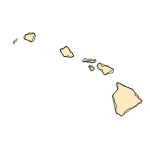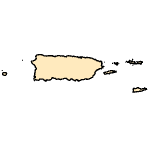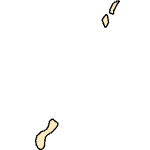Notropis procne
(Swallowtail Shiner)
Fishes
Native Transplant |
|
Common name: Swallowtail Shiner
Taxonomy: available through
www.itis.gov
Identification: Smith (1985); Page and Burr (1991); Jenkins and Burkhead (1994). Two subspecies are recognized, N. p. procne and N. p. longiceps (Gilbert 1998; but see Jenkins and Burkhead 1994).
Size: 7.2 cm.
Native Range: Atlantic drainages, above and below Fall Line, from Delaware and Susquehanna rivers, New York, to Santee River, South Carolina (Page and Burr 1991); also Lake Ontario drainage, New York (Page and Burr 1991; but see Smith 1985).



|

Alaska |

Hawaii |

Puerto Rico &
Virgin Islands |

Guam Saipan |
Hydrologic Unit Codes (HUCs) Explained
Interactive maps: Point Distribution Maps
Nonindigenous Occurrences:
Table 1. States with nonindigenous occurrences, the earliest and latest observations in each state, and the tally and names of HUCs with observations†. Names and dates are hyperlinked to their relevant specimen records. The list of references for all nonindigenous occurrences of Notropis procne are found here.
Table last updated 12/19/2025
† Populations may not be currently present.
Means of Introduction: Unknown; possible bait bucket releases in North Carolina and Virginia. Although, Jenkins and Burkhead (1994) speculated that it had been introduced into the New River drainage of Virginia during the 1960s, they noted that the first valid record of this species from that drainage was from 1971. The first record of this species in the Linville River of North Carolina was 1990 (Johnston et al. 1995). Johnston et al. (1995) discovered this species in the Linville River, North Carolina, in 1990. They stated that the new record perhaps indicates the "spread of this species or introduction by fishermen." This species was collected from Catherine Creek, New York in 1927; and from Lake Ontario in 1951 (Lee et al. 1980 et seq.). Smith (1985) speculated that the occurrence of the subspecies Notropis procne procne in Catherine Creek, the inlet to Seneca Lake in New York, may have resulted from dispersal via an artificial canal; however, Smith also hypothesized that it may have entered the area as a result of natural events during postglacial times. In their summary table on fishes of the Great Lakes basin, Bailey and Smith (1981) indicated that Notropis procne had colonized tributaries of Lake Ontario recently via canal or by natural dispersal following introduction.
Status: Established in North Carolina, Virginia, and West Virginia. Reported in New York.
Impact of Introduction: The impacts of this species are currently unknown, as no studies have been done to determine how it has affected ecosystems in the invaded range. The absence of data does not equate to lack of effects. It does, however, mean that research is required to evaluate effects before conclusions can be made.
Other Resources:
FishBase Summary
Author:
Leo Nico, and Pam Fuller
Revision Date: 7/6/2000
Peer Review Date: 7/6/2000
Citation Information:
Leo Nico, and Pam Fuller, 2025, Notropis procne (Cope, 1865): U.S. Geological Survey, Nonindigenous Aquatic Species Database, Gainesville, FL, https://nas.er.usgs.gov/queries/FactSheet.aspx?speciesID=607, Revision Date: 7/6/2000, Peer Review Date: 7/6/2000, Access Date: 12/19/2025
This information is preliminary or provisional and is subject to revision. It is being provided to meet the need for timely best science. The information has not received final approval by the U.S. Geological Survey (USGS) and is provided on the condition that neither the USGS nor the U.S. Government shall be held liable for any damages resulting from the authorized or unauthorized use of the information.